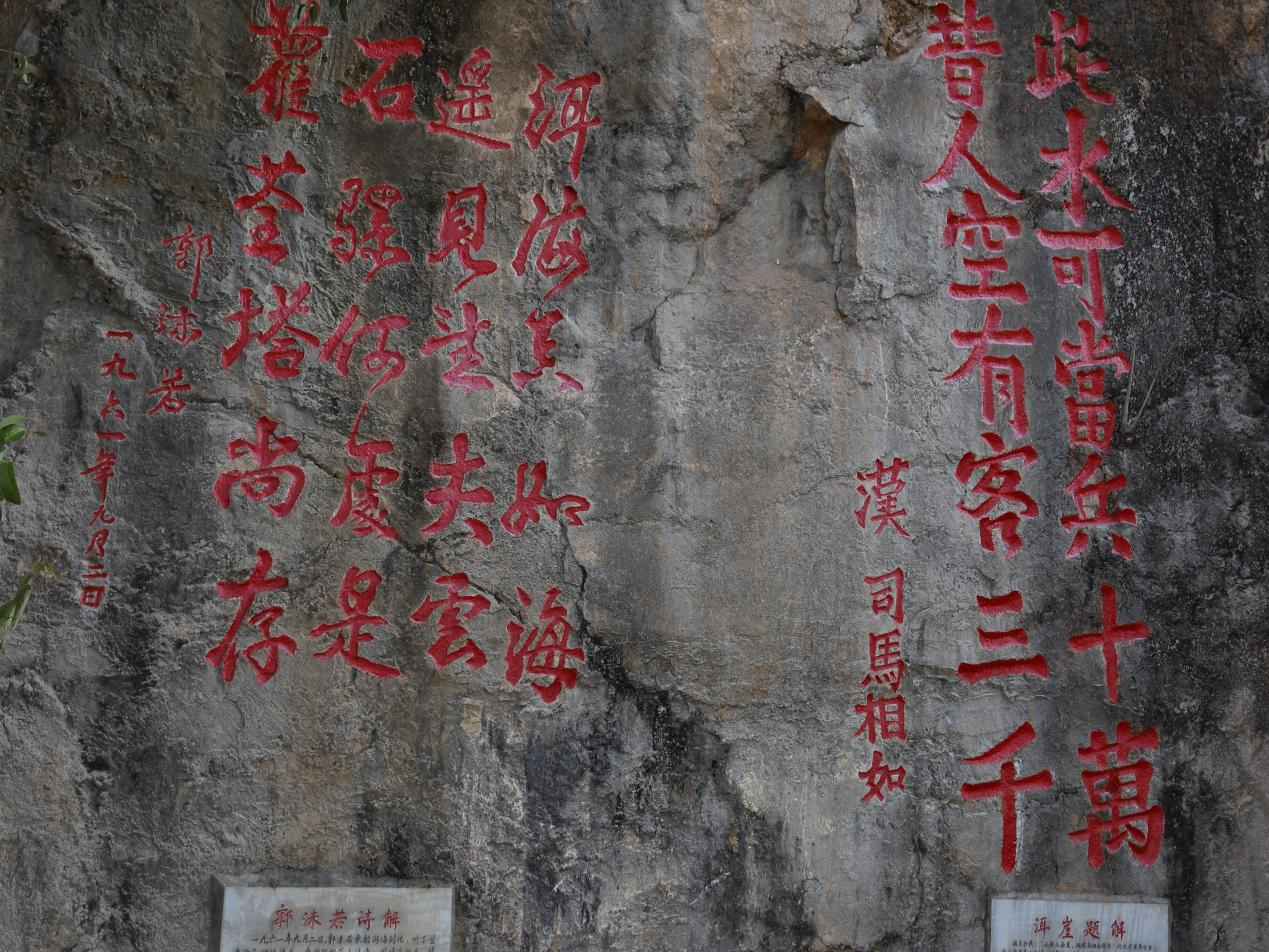Cliff inscription
Many stone carvings originally existed on the coastal cliffs of Luquan Peninsula, but unfortunately, most were destroyed by quarrymen. The only remaining stone carving is a Ming Dynasty inscription on the cliff face near the ancient Luquan ferry. This is less than 100 meters from Guanyin Pavilion at the western end and less than 100 meters from Luquan Temple at the northeast corner. However, there is no access path; to view it, one must look upwards from the beach below the cliff during the dry season. When the tide is high, one can only view it by boat.
Keyword:
Dali Luoquan
Luoquan Peninsula
Luoquan Pagoda
Tianjing Pavilion
Category:
Spot Description
Ming Dynasty Stone Carvings
Many stone carvings originally existed on the coastal cliffs of Luquan Peninsula. Sadly, most were destroyed by quarrymen. The only remaining carving is located on the cliff face near the ancient Luquan ferry. It's less than 100 meters from Guanyin Pavilion to the west and less than 100 meters from Luquan Temple to the northeast. However, there's no path leading to it. To view it, one must look upwards from the beach below during the dry season. During high tide, viewing is only possible by boat.
In winter 2005, the scenic area used scaffolding to ensure safety, allowing people to climb to within a few meters of the carvings for closer examination. Except for a small portion that was weathered and illegible, the inscriptions have been outlined in black acrylic paint. The title of the carving is “Qixi Fan Er Ge Ci Yun”,written in traditional vertical style from right to left. The inscription is signed “Wanli Xinsi Haiyang Shaofeng Zhang Yu Shen Shu” (万历辛巳海阳少峰章曰慎书). The characters are neat and elegant. The carving is approximately 3 meters wide and 1.5 meters high, covering nearly 5 square meters. According to historical records, Zhang Yu Shen was from Haiyang, an imperial examination candidate, and served as a Dali Prefecture judge during the Wanli reign of the Ming Dynasty.
Er Rock Inscription
The 1912 edition of "Haidong Zhi" records: “Er Rock Inscription, located on the west cliff of Yu'an Mountain, with the inscription by Han Dynasty official Sima Xiangru: ‘This water can withstand an army of 100,000, while in the past, there were only 3,000 guests.’" The 1912 draft of "Dali County Annals" also records: “Tianjing Pavilion: Located on Yu'an Mountain east of Erhai Lake, with the inscription between the collapsed rocks: ‘This water can withstand an army of 100,000, while in the past, there were only 3,000 guests.’" Sadly, the original site was destroyed by quarrymen. However, some elderly people who had seen the inscription still remember it. The 2003 publication of Wang Fu's "Lu Chuan Zhi Gao"also mentions the "Er Rock Inscription," stating that it was "located on the cliff by Erhai Lake at the border of Benchuan (Wase) and Haidong Township, and no longer exists." Wang Fu's book also mentions an interview with Zhao Xiang, a retired cadre from Wase Village, born in 1922, who said he had seen the "Er Rock Inscription" before liberation, with the inscription: ‘This water can withstand an army of 100,000, while in the past, there were only 3,000 guests.’
The scenic area has newly carved "Er Cliff Inscription" on the cliff east of the newly built pier and embedded a marble inscription of "Er Cliff Inscription Explanation" below it:
Local gazetteers record: "On the west cliff of Yu'an Mountain, Han Dynasty official Sima Xiangru inscribed: ‘This water can withstand an army of 100,000, while in the past, there were only 3,000 guests.’" It also records that "Han Dynasty official Sima Xiangru went to Yu'an Mountain to request the opening of Yizhou. Sima Qian also visited here." Bai nationality scholar Li Yuanyang of the Ming Dynasty wrote in his poem "Yuji Island": "Erhai's wild waves shake the blue sky, the island floats like a jade stand, a sign of famous scholars. Han Dynasty's two Sima officials stopped their chariots here, to initiate literature and prosperity." In fact, official history records that during the Yuan Guang years of Emperor Wu of the Han Dynasty, Sima Xiangru was sent on a mission to the Southwest Yi, and Emperor Wu adopted the suggestions of Tang Meng, Sima Xiangru, and Zhang Qian to open up the border, establishing counties in the Southwest Yi, and establishing Yizhou County in Yuanfeng 2 (109 BC). This shows that the Dali region had long been integrated with the Central Plains.
Due to the passage of time, the original "Er Cliff Inscription" by Sima Xiangru was destroyed by quarrymen. This cliff has been chosen to recreate it.
The "Er Cliff Inscription" is also called "Cliff Inscription" in some gazetteers. The original site was destroyed by quarrymen, making it difficult to fully restore its original appearance. The creator of the original inscription is debated; some say it was Sima Xiangru, others Sima Qian, and still others say it was a Nan Zhao king who used the dangerous terrain of Erhai Lake. The recreated "Er Cliff Inscription" is attributed to Sima Xiangru based on records in the 1912 "Haidong Zhi" and other local gazetteers. This may be a unilateral conclusion that contradicts historical facts. However, some gazetteers do not specify the author, making it even more difficult to determine the author. The author of the "Er Cliff Inscription" remains a question, but its existence on the west cliff of Yu'an Mountain on the east bank of Erhai Lake is undeniable. It is recorded in various local gazetteers, including Zhuge Yuansheng's "Dian Shi" and Li Yuanyang's "Dali Fu Zhi" from the Ming Dynasty, Zhou Yue's "Bin Chuan Zhou Zhi" from the Qing Dynasty, the early Republic of China's "Dali County Annals Draft", and Li Wenrong's "Haidong Zhi" . The "Er Cliff Inscription" naturally attracts tourists. Some, to avoid the suspicion of "appropriating credit" and being ridiculed for "Dali's shallowness... failing to live up to the title of ‘literate prefecture’", have attempted to "separate the true from the false" and carefully "investigated" the inscription, believing that "from the Ming Dynasty's Dali scholars Yang Shiyun, "Cang'er Tu Shuo" , Hanlin Li Yuanyang, Bin Chuan Prefecture Magistrate Zhou Yue of the Yongzheng reign, Wuling native Hu Wei who revised "Nan Zhao Ye Shi" during the Qianlong reign, to the early Republic of China's "Dali County Annals Draft", all have followed the same line, ‘relying on hearsay and false writing’. Only after climbing the cliff to view it did they realize it was a Yuan Dynasty inscription, including a five-character poem by Shulu Wu, with calligraphy in the style of ‘Seventeen Posts’." They then state that examining the source of these two poems, from Li Yi's "Jie'an Lao Ren Man Bi", volume 5, "Junshan Fu Yuan Tang Jiu Lian", contains a couplet by Li Hetian Yu (Song Dynasty, Jishui, Jiangxi): ‘This water can withstand an army of 100,000, while in the past, there were 3,000 guests.’" It then continues: "Further examination reveals that this passage from Li Yi's "Man Bi" is quoted from Wei Anjun's "Mei Shi Jian Shi Hua" of the Southern Song Dynasty." The investigation goes on and on, without reaching a convincing conclusion. Li Yi, Yang Shiyun, Li Yuanyang, and Zhuge Yuansheng were all Ming Dynasty figures. Yang Shiyun, Li Yuanyang, etc., relying on hearsay and false writing, are not credible, so what Li Yi wrote is necessarily credible? Moreover, "This water can withstand an army of 100,000, while in the past, there were only 3,000 guests" and "This water can withstand an army of 100,000, while in the past, there were 3,000 guests" are not exactly the same; who imitated whom is uncertain. As for whether it is a "Yuan Dynasty inscription", one can look at the Yuan Dynasty poet Shulu Jie's five-character poem "West Erhai River".
How majestic is Erhai Lake, its source from Dengchuan. Two passes, dragon's head and tail, nine bends winding.
Dali city is strong, with iron walls and stone fortifications. Four islands have been called since ancient times, three islands still exist today.
Luoge relies on its steepness, Mongols rely on the remote border. To withstand an army of 100,000, not counting 3,000 guests.
On the day of the emperor's expedition, reunification was achieved. The rain master cleared the miasma, the wind master swept away the haze.
The people prosper and the land is rich, the borders have been peaceful for a hundred years. The scenery of Diancang Mountain is beautiful, and the inscription remains.
From the poem, it can be seen that it is because of the "Er Cliff Inscription" that there are the lines "Luoge leans on the dangerous cliffs, the Meng people rely on the far border. Ten thousand soldiers are needed, not three thousand guests." It is not that the "Er Cliff Inscription" is the same as "Ten thousand soldiers are needed, not three thousand guests." If it is said to originate from Song Dynasty people, then it is earlier than the Nanzhao King. In fact, the allusion of "three thousand guests" comes from the Spring and Autumn and Warring States periods, and it is possible that both the Tang and Han dynasties used this allusion. Sima Xiangru and Sima Qian both served as envoys to the Southwest Yi and reached the Erhai Lake area, which is historically verifiable. Xu Jiarui's "History of Ancient Dali Culture" has a section on "the years when the two Sima entered the Southwest," which confirms through citations from the "Han Shu" and other relevant historical materials that Xiangru's mission was in the sixth year of Yuan Guang (129 BC), with Wang Ran, Lü Yue and others as deputy envoys; Zichang (Sima Qian)'s mission was in the first year of Yuanfeng (110 BC); "Zichang's brief visit to Kunming (referring to Dali) was nineteen years after Xiangru." The book also specifically states: "In the Han Dynasty, in order to communicate with India, the Southwest Yi was developed. Therefore, the contemporary literary masters and the great historians all participated in the task, personally went to the vicinity of Dali, and had a great influence on the culture." Those who know the allusion of "Han warships" in the long couplet of Kunming Daguan Pavilion will naturally think of the importance of Erhai Lake, and when tourists pay attention to the "Er Cliff Inscription," they will naturally think of the allusion of "Han warships." Erhai Lake was called Kunmi Chuan and Ye Yu Shui in the Han Dynasty, Xi Er River in the Tang Dynasty, and Erhai Lake from the Ming Dynasty onwards. The fact that the "Er Cliff Inscription" refers to "this water" without mentioning "sea" seems to also indicate that the inscription dates back to the Han and Tang dynasties and not much later. The "Er Cliff Inscription" is well-matched, and if it was not really written by Sima Xiangru or Sima Qian, it is not unreasonable for someone to associate it with the famous ancient literary figures "the two Sima." This is understandable. Imagine, even famous Bai ethnic writers such as Yang Shiyun and Li Yuanyang followed the crowd, "using their ears as mouths and their pens as books," let alone others? For the "Er Cliff Inscription," we must find a very convincing source and thoroughly solve the question of "who made it" before we can deny the conclusion that it was not made by the Sima of the Han Dynasty. Let the enthusiastic people repeatedly "investigate" and help us unravel this mystery!
If the discussion of this topic does not yield ideal results for the time being, the "Dali cultural people" need not worry too much. As long as it is not groundless nonsense or pretentious profundity, there is no need to be afraid of being laughed at for being shallow. Local histories often supplement the shortcomings of official histories, and even official histories are not necessarily absolutely reliable word for word. It is a good thing to have local gazetteers and unofficial histories for our reference and research; we should take a positive attitude and make use of them. We should not always think that the "Southwest Yi" is backward and doubt everything, losing our confidence in research and not daring to boldly explore. Some discoveries are really unexpected! For example, the discovery of "Yuanmou Man" pushed the history of mankind in our country forward from 500,000 to 600,000 years ago to 1.7 million years ago. In 2006, the archaeological excavation of the Haidong Yinsuo Island (formerly known as Yuji Island) shell mound site, dated by "carbon 14" to about 5,000 years ago, proved that the history of the Dali region and the Chinese nation are synchronized for five thousand years, not "four thousand years." Fu Yongfa's "Discoveries of Shenzhou: A Geographical Study of the Shan Hai Jing" defines western Yunnan as ancient China, saying that "the western Yunnan region is the original birthplace of our Chinese nation and Chinese culture, the cradle of our nation and the root of our nation." Of course, "Discoveries of Shenzhou" is only one opinion, and whether or not to believe it is up to the individual. But we are inspired by this, and we cannot blindly underestimate the Dali region of western Yunnan. Dali is indeed worth studying. Especially Haidong, some people believe that due to geological changes, Haixi was originally lower than Haidong, and later due to mountain-building movements, Haixi gradually became higher than Haidong, so Haidong was developed earlier than Haixi, which can be confirmed by some unearthed cultural relics. This statement seems to make some sense. Due to historical changes, some early cultural relics in Haidong have been buried by time and await excavation and exploration. According to historical records, there was a Buddhist pagoda in Haidong in 675 AD (the second year of Tang Shangyuan). Zhuge Yuansheng's "Dian Shi" records: "Xiangru, having failed to persuade the elders of Shu with his words, entered Dian and arrived at Ye Yu River East. Upon his return, he submitted a memorial requesting the opening of Yizhou." "Ye Yu River is in Dali, and the route from Shu to Dian passes through here. Sima Qian, a Langzhong in the Yuanfeng period, also came here to observe the Xi Er River." There is a legend of Sima's lecture platform in Haidong. These can lead us to think about extremely attractive historical research topics related to the "Er Cliff Inscription." As long as enthusiastic people dare to explore and earnestly seek evidence, they will surely make discoveries and achieve results. Let the newly carved "Er Cliff Inscription" serve as a catalyst, encouraging those who are interested to contribute their ideas and insights!
Next to the newly carved "Er Cliff Inscription" is an inscription of a poem written by Guo Moruo when he visited Erhai Lake in 1961.
On September 2, 1961, Guo Moruo took a boat to visit the lake. After hearing the legend of "Waiting Wife Cloud," he was inspired to look around Cangshan Mountain and Erhai Lake. Because it was autumn, the "Waiting Wife Cloud" was unlikely to appear, and the stone mule in the legend was also invisible due to the rising water level. Only Luoquan Pagoda was still there (destroyed in 1966), so he happily improvised a quatrain: "Erhai is truly like a sea, the Waiting Wife Cloud is not seen. Where is the stone mule? Luoquan Pagoda still exists."
Now, some publications have published the poem as: "Erhai is truly like a sea, Luoquan Pagoda still exists. Where is the stone mule? The Waiting Wife Cloud is not seen." There seems to be some controversy about this; who is right and who is wrong remains to be verified.
According to the recollections of staff members who participated in receiving Guo Moruo's visit to Dali at that time, there were slight differences between the poem published by Guo Lao after returning to Beijing and the one he improvised at the time.
Zhou Baili's article "Guo Moruo's Poems Praising Dali" (see the "San Yi Leisure Talk" column of the Yunnan Daily on November 17, 1996) states that in the early autumn of 1961, Guo Moruo led a delegation of the National People's Congress to Indonesia and Myanmar for a friendly visit, and visited Dali on his way back to China. On September 8, he visited Butterfly Spring, and in the afternoon, he took a boat to tour Erhai Lake. On the boat, Bai ethnic artist Yang Han sang the "Daben Qu: Cang'er Scenery," and the male and female actors of the prefectural song and dance troupe sang several Bai ethnic folk songs. Guo Lao listened and praised them highly. At that time, Yang Han pointed to the stone mule in the sea and told Guo Lao the story of "Waiting Wife Cloud." Guo Lao was "moved and seemed to be inspired" and immediately wrote a five-character quatrain. It seems that Guo Moruo's visit to Erhai Lake was in early autumn, and he did not actually see the "Waiting Wife Cloud."
Recommended Attractions
Wind, Flower, Snow, Moon Pavilion
The First Pavilion of Erhai Lake - Tianjing Pavilion






